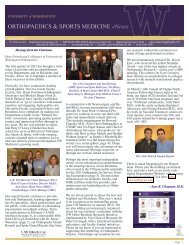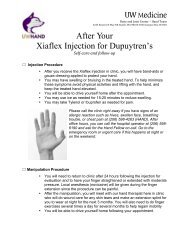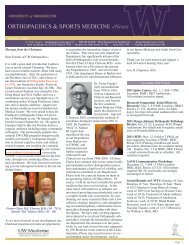2002 - University of Washington Bone and Joint Sources
2002 - University of Washington Bone and Joint Sources
2002 - University of Washington Bone and Joint Sources
You also want an ePaper? Increase the reach of your titles
YUMPU automatically turns print PDFs into web optimized ePapers that Google loves.
My Dad The Shooter - A Case For Specialization<br />
JAMES W. STRICKLAND, M.D.<br />
My dad could really shoot the<br />
basketball. He developed his<br />
skills in the small town <strong>of</strong><br />
Owensville Indiana (pop. 450) where<br />
growing boys had little else to do but<br />
play basketball. Dad’s father was an old<br />
time country doctor who was<br />
frequently called away to tend to the<br />
sick, make house calls or deliver babies.<br />
As a result dad had alot <strong>of</strong> time alone<br />
<strong>and</strong> he spent it like many rural Indiana<br />
boys did; shooting baskets. He spent<br />
countless solitary hours in his back yard<br />
on a wide dirt patch where the grass had<br />
been worn away by the constant impact<br />
<strong>of</strong> basketballs <strong>and</strong> tennis shoes. At the<br />
back <strong>of</strong> the patch was a basketball goal<br />
not unlike thous<strong>and</strong>s <strong>of</strong> others which<br />
could be seen throughout the Indiana<br />
countryside <strong>and</strong> from which numerous<br />
wonderful Hoosier players have been<br />
spawned over the years. The goal, which<br />
his father had erected for him, consisted<br />
<strong>of</strong> a wooden backboard with a black<br />
metal rim <strong>and</strong> a ragged grey net<br />
supported by, a stout, rusted metal pipe<br />
firmly anchored in the ground with<br />
concrete. Dad’s unchanging routine<br />
consisted <strong>of</strong> monotonously dribbling a<br />
worn leather ball out to a variety <strong>of</strong><br />
positions well away from the goal; he<br />
would then turn, square himself with<br />
the basket <strong>and</strong> shoot the classic<br />
two-h<strong>and</strong>ed set shot that would<br />
become his trade mark. He would then<br />
follow the ball to the basket, retrieve it<br />
<strong>and</strong> shoot again. This sequence would<br />
be repeated time after time until my<br />
gr<strong>and</strong>mother would call him in or it<br />
became too dark for him to continue.<br />
These private shooting practices were<br />
a year around ritual. Occasionally he<br />
would be joined by other boys <strong>and</strong> they<br />
would go to another goal around town<br />
or the high school gymnasium where<br />
they would play pick-up games. But, for<br />
the most part, it was a lonely self<br />
discipline <strong>and</strong> it produced a very good<br />
shooter.<br />
For a small town, the Owensville<br />
boys basketball team was pretty<br />
competitive <strong>and</strong> dad was easily their<br />
best player. He was big boned, about six<br />
feet tall by his Junior year <strong>and</strong> he<br />
quickly learned to use his height <strong>and</strong><br />
weight to his advantage. He possessed<br />
an innate underst<strong>and</strong>ing <strong>of</strong> the game,<br />
was an intense competitor <strong>and</strong>, above<br />
all, he became a deadly shooter from<br />
almost any position on the court. From<br />
1924 until 1926 Owensville won a lot<br />
<strong>of</strong> games. They beat the big Evansville<br />
teams on a regular basis, won their<br />
sectional tournament two out <strong>of</strong> three<br />
years <strong>and</strong> almost never lost in the<br />
confines <strong>of</strong> their own gym; which,<br />
incidentally, is believed to have had the<br />
first glass backboards in the state <strong>of</strong><br />
Indiana. The gym also had a well<br />
localized dead spot on the basketball<br />
floor <strong>and</strong> the members <strong>of</strong> the team<br />
learned to entice opposing players to<br />
dribble over the spot during crucial<br />
moments <strong>of</strong> a game. When the ball<br />
failed to return to the dribbler’s h<strong>and</strong><br />
the anticipating defensive player would<br />
scoop it up <strong>and</strong> proceed unmolested for<br />
a basket.<br />
From Owensville, dad went 100<br />
miles northeast to Indiana <strong>University</strong><br />
where he played for Everett Dean <strong>and</strong><br />
with Indiana legend Branch<br />
McCracken. He led the team in scoring<br />
his junior years <strong>and</strong> was selected as<br />
Indiana’s second All-American (third<br />
team, College Humor Magazine) in<br />
1929. As a Senior, his playing time was<br />
restricted to a half <strong>of</strong> each game by a<br />
physician who thought he detected a<br />
heart murmur. Throughout his college<br />
career dad’s shooting ability was the<br />
predominate feature <strong>of</strong> his game. It was<br />
described in at least one national sports<br />
publication as the classic, perfect form,<br />
underh<strong>and</strong>ed set shot.<br />
After college, dad went to New York<br />
City where he played for five years at<br />
what was then the mecca <strong>of</strong> U.S.<br />
amateur sports, the New York Athletic<br />
Club. During those years he taught <strong>and</strong><br />
coached underprivileged boys at a<br />
church <strong>and</strong> played pr<strong>of</strong>essional<br />
basketball in upstate New York under<br />
the name Stricklevitch in order to make<br />
some money <strong>and</strong> preserve his amateur<br />
status. When mother, announced that<br />
I was on the way in 1935, dad decided<br />
that they should return home to<br />
Indianapolis to settle down <strong>and</strong> raise a<br />
family. Dad would not play organized<br />
basketball again, but that shot; that<br />
glorious shot, became famous in every<br />
neighborhood we ever lived in.<br />
No basketball player today, at any<br />
level, shoots the ball the way players did<br />
back then. I truly believe, that dad’s<br />
form was absolutely text book for the<br />
two-h<strong>and</strong>ed shot. He was a big man for<br />
that time at six feet one <strong>and</strong> he weighed<br />
210 pounds. His h<strong>and</strong>s were fairly large<br />
but he could barely palm the laced<br />
leather basketballs <strong>of</strong> his period.<br />
Perhaps the key to the shot was the way<br />
he positioned his h<strong>and</strong>s on the ball. His<br />
fingers were spread to maximum<br />
separation <strong>and</strong> placed on each side <strong>of</strong><br />
the ball with his thumbs pointed<br />
straight upward <strong>and</strong> his fingers aligned<br />
directly out from his body. The shot was<br />
started just above the waist <strong>and</strong> about<br />
six inches out from his body with the<br />
wrists straight ahead. He would initiate<br />
the shot by pulling his arms back<br />
slightly at the shoulder <strong>and</strong> rotating his<br />
h<strong>and</strong>s so that his fingers were pointing<br />
downward <strong>and</strong> his thumbs were<br />
pointing out towards the basket. This<br />
motion was quickly reversed as his arms<br />
thrust forward at the shoulder <strong>and</strong> his<br />
wrists snapped upward. His h<strong>and</strong>s were<br />
well past their original position with his<br />
thumbs pointed towards his body at the<br />
time <strong>of</strong> release. This rolling movement<br />
resulted in a tremendous amount <strong>of</strong><br />
backspin; more, I believe, than most<br />
players today achieve with their<br />
one-h<strong>and</strong>ed shots. The trajectory <strong>and</strong><br />
direction <strong>of</strong> dad’s shot was rarely<br />
inaccurate <strong>and</strong> he would only miss if<br />
the shot was a bit long or short. Even<br />
then, the s<strong>of</strong>tness <strong>of</strong> the<br />
semi-underh<strong>and</strong>ed delivery <strong>and</strong> the<br />
reversed spin that he created would<br />
<strong>of</strong>ten hold the ball to the rim where,<br />
after a bounce or two, it would almost<br />
always fall through. He could hit that<br />
shot with deadly accuracy from five to<br />
thirty feet from the basket with only<br />
slight variation in his basic form. Free<br />
throws were almost automatic <strong>and</strong>,<br />
after he retired from active competition,<br />
he could st<strong>and</strong> at any free-throw line<br />
<strong>and</strong> hit shot after shot with the ball<br />
rarely touching the rim.<br />
From 1941 until 1946, dad was the<br />
Indiana Director <strong>of</strong> the Office <strong>of</strong> Price<br />
Administration (OPA) <strong>and</strong> was<br />
subsequently asked to run for Governor<br />
2 <strong>2002</strong> ORTHOPAEDIC RESEARCH REPORT















